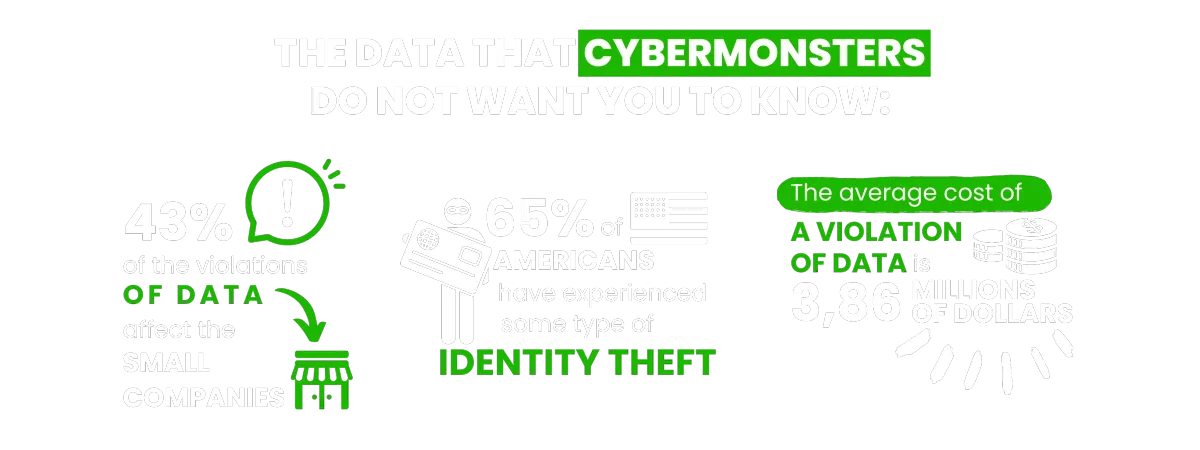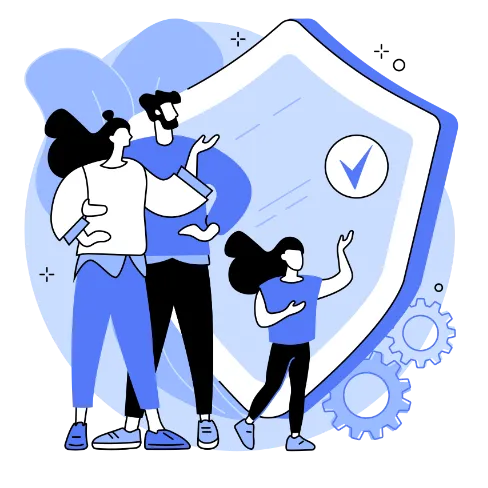Fortify Your Business with
Way2Protect's Ultimate Cybersecurity Shield
Transform cybersecurity from a challenge into your competitive advantage.
Fortify Your Business with Way2Protect's Ultimate Cybersecurity Shield
Transform cybersecurity from a challenge into your competitive advantage.

You find these and other figures in my book Happily Ever Cyber and on Cisa.gov

Find out how to push Cybermonsters away from your private data
With tips to help prevent a cyber attack protecting your family, work environment and yourself:
AS SEEN ON:


Find out how to push Cybermonsters away from your private data
With tips to help prevent a cyber attack protecting your family, work environment and yourself:
AS SEEN ON:

Push Cybermonsters away from your private data.
Subscribe to my newsletter about cybersecurity and cyber safety. New issues every Tuesday.

Push Cybermonsters away from your private data.
Subscribe to my newsletter about cybersecurity and cyber safety. New issues every Tuesday.

Protect those that matters most to you:

Family
Protect your child(ren), teens,
and your parents.

Business Owners
Protect your data, your customer's information, your employees,
and your brand!

Yourself
Have peace of mind online!
International Bestselling & Award-Winning Cyber Safety Author
Identity theft & cyber crime can happen to anyone.




Why choosing us?
In a world full of digital distractions, we understand the importance of cultivating a healthy balance. At Way2Protect, our mission is clear: to be your trusted guide to a conscious and protected online experience, both for you and for what you value most: your family, your business, and your peace of mind.
Way2Protect becomes your fundamental ally in your digital world, providing you with hassle-free security and adapting cybersecurity practices to your routine without sacrificing your time. We facilitate the process, guiding you in the implementation of effective cybersecurity practices to protect your family, your business, and your work teams.
Why choosing us?
In a world full of digital distractions, we understand the importance of cultivating a healthy balance. At Way2Protect, our mission is clear: to be your trusted guide to a conscious and protected online experience, both for you and for what you value most: your family, your business, and your peace of mind.
Way2Protect becomes your fundamental ally in your digital world, providing you with hassle-free security and adapting cybersecurity practices to your routine without sacrificing your time. We facilitate the process, guiding you in the implementation of effective cybersecurity practices to protect your family, your business, and your work teams.

Get the latest news in the Cyber Security World

5 Easy Steps to Keep Your Family Safe Online: A Comprehensive Guide for Parents
5 Easy Steps to Keep Your Family Safe Online: A Comprehensive Guide for Parents
In a world where the digital landscape is vast and sometimes risky, ensuring the online safety of our families has become a top concern for parents everywhere. The internet is a treasure trove of information and opportunities, but it also has potential dangers that can affect the well-being of our children. This guide aims to equip parents with practical, actionable steps to create a safer online environment for their families, without compromising the benefits that technology brings to our daily lives.
The Digital Dilemma: Balancing Connectivity and Safety
As we navigate the 21st century, it's clear that digital literacy and online safety are essential skills. Children today grow up with technology integrated into almost every aspect of their lives, from education to entertainment. However, this constant connectivity comes with its own set of challenges. Cyberbullying, online predators, exposure to inappropriate content, and data privacy concerns are just a few issues parents must address.
The good news is that with the right approach and tools, it's possible to create a safe digital environment for your family without extreme measures. By following these five steps, you can significantly reduce online risks and promote a culture of digital responsibility in your household.
Step 1: Educate Yourself and Your Children
The foundation of online safety starts with education. As a parent, it's crucial to stay informed about the latest online trends, platforms, and potential risks. This doesn't mean you need to become a cybersecurity expert, but understanding the digital world will help you make informed decisions and have meaningful conversations with your children.
Start by researching common online threats such as phishing scams, cyberbullying, and privacy breaches. Familiarize yourself with the social media platforms and apps your children use. Websites like Common Sense Media and the National Cyber Security Alliance offer excellent resources for parents looking to learn about digital safety.
Once you've built a knowledge base, share this information with your children. Open, honest communication is key. Discuss the potential dangers of the internet in an age-appropriate manner, emphasizing that these conversations come from a place of care rather than restriction. Teach them about the permanence of online actions, the importance of protecting personal information, and how to recognize and report inappropriate behavior.
Example: Consider setting up regular "tech talks" with your family to discuss recent online experiences, share new learnings, and address any concerns. This ongoing dialogue creates a supportive environment where your children feel comfortable coming to you with questions or issues they encounter online.

Step 2: Implement Robust Parental Controls
While education is the backbone of online safety, technological solutions provide an additional layer of protection. Parental controls allow you to monitor and restrict what your children can access online. These can be implemented at various levels, from individual devices to your home network.
Start by exploring the built-in parental control features on your children's devices. Most smartphones, tablets, and computers have options to restrict app installations, in-app purchases, and access to explicit content. For instance, Apple's Screen Time and Google's Family Link offer comprehensive tools for iOS and Android devices, respectively.
Next, consider installing parental control software across all devices. Programs like Norton Family, Qustodio, or Kaspersky Safe Kids offer features such as web filtering, time limits, location tracking, and detailed activity reports. These tools can be particularly useful for younger children or in households where more oversight is necessary.
Example: Don’t forget about your home network. Many modern routers come with parental control features that allow you to set internet schedules, block specific websites, and even pause the internet for certain devices. If your router doesn’t have these capabilities, consider upgrading to one that does, or look into network-level solutions like Circle with Disney or OpenDNS.
Remember, the goal of parental controls is not to spy on your children but to create boundaries that protect them from accidental exposure to inappropriate content and help manage their screen time. As your children grow older and demonstrate responsible online behavior, you can gradually adjust these controls to give them more freedom.
Step 3: Secure Your Home Network
Your home network is the gateway to the internet for all your family's devices, making it a critical point of focus for online safety. A secure home network not only protects your family from external threats but also safeguards your personal data and privacy.
Start by ensuring that your Wi-Fi network is protected with a strong, unique password. Avoid using easily guessable information like birthdates or phone numbers. Instead, opt for a long passphrase that combines uppercase and lowercase letters, numbers, and symbols. Change this password regularly, especially if you've shared it with guests.
Example: Enable WPA3 encryption on your router if available, or at minimum, use WPA2. This encrypts the data transmitted over your network, making it much harder for malicious actors to intercept. Additionally, disable WPS (Wi-Fi Protected Setup) as this feature can be exploited by hackers to gain access to your network.
Regularly update your router's firmware. These updates often include security patches that address newly discovered vulnerabilities. Many modern routers can perform automatic updates, but if yours doesn't, make it a habit to check for updates monthly.
Consider setting up a guest network for visitors or IoT devices. This keeps your main network separate and more secure. Some routers also allow you to create a separate network for your children's devices, giving you more control over their internet access without affecting other household members.
Lastly, use a reputable VPN (Virtual Private Network) service, especially when accessing sensitive information or using public Wi-Fi networks. A VPN encrypts your internet traffic, making it much harder for others to intercept or spy on your online activities.
Step 4: Foster Digital Citizenship
While technical solutions are important, cultivating a sense of digital citizenship in your children is equally crucial. Digital citizenship refers to the responsible and ethical use of technology and the internet. By instilling these values early on, you're equipping your children with the skills they need to navigate the digital world safely and respectfully, even when they're not under your direct supervision.
Start by teaching your children about digital etiquette. This includes being respectful in online interactions, not engaging in cyberbullying, and understanding the impact their words and actions can have in the digital space. Emphasize the importance of empathy and kindness online, just as they would practice in face-to-face interactions.
Example: Discuss the concept of digital footprints – the trail of data we leave behind with every online interaction. Help your children understand that once something is posted online, it can be difficult or impossible to completely remove. Encourage them to think critically before sharing personal information, photos, or opinions online.
Teach your children about copyright and intellectual property. Explain the importance of respecting others' creative work and how to properly cite sources when using information found online. This not only fosters ethical behavior but also develops critical thinking skills.
Address the issue of screen time and digital balance. Help your children understand the importance of balancing online and offline activities. Encourage them to engage in physical activities, face-to-face social interactions, and pursue offline hobbies. Consider creating "tech-free" zones or times in your home to promote family bonding and reduce excessive screen time.
Lastly, model good digital citizenship yourself. Children often learn more from what we do than what we say, so be mindful of your own online behavior and screen time habits.

Step 5: Stay Vigilant and Adapt
The digital landscape is constantly evolving, with new platforms, technologies, and potential risks emerging regularly. As such, online safety isn't a one-time setup but an ongoing process that requires vigilance and adaptability.
Make it a habit to stay informed about the latest online trends and safety issues. Follow reputable tech news sources, join online parent forums, or subscribe to newsletters from organizations focused on internet safety. This will help you stay ahead of potential risks and adjust your family's online safety strategy accordingly.
Regularly review and update your parental controls and security settings. As your children grow older, their online needs and capabilities will change. Be prepared to adjust restrictions and have ongoing conversations about responsible internet use.
Pay attention to your children's online behavior and mood. Sudden changes in internet usage patterns or emotional states could be indicators of online issues such as cyberbullying or inappropriate content exposure. Create an open environment where your children feel comfortable coming to you with concerns or questions about their online experiences.
Example: Consider conducting periodic "digital audits" of your family's devices and online accounts. This might include reviewing privacy settings on social media accounts, checking for unnecessary app permissions, and ensuring all software and operating systems are up to date.
Lastly, be prepared to seek help if needed. If you encounter a situation that feels beyond your expertise, don't hesitate to reach out to school counselors, local law enforcement, or cybersecurity professionals for guidance.
Conclusion: Empowering Families in the Digital Age
As we navigate the complexities of the digital age, ensuring our families' online safety has become an integral part of modern parenting. By following these five steps – educating yourself and your children, implementing robust parental controls, securing your home network, fostering digital citizenship, and staying vigilant – you can create a safer online environment for your family.
Remember, the goal isn't to create a digital fortress that completely isolates your children from the online world. Rather, it's about equipping them with the knowledge, tools, and values they need to navigate the digital landscape safely and responsibly. By taking a proactive and balanced approach to online safety, you're not just protecting your family from immediate threats – you're investing in their long-term digital well-being and helping them develop crucial skills for the future.
As you implement these strategies, keep the lines of communication open with your children. Encourage them to share their online experiences, both positive and negative. Celebrate their responsible digital behavior and use missteps as learning opportunities. With patience, persistence, and a commitment to ongoing education, you can help your family thrive in the digital world while staying safe from its potential pitfalls.
Call to Action
Start implementing these steps today to enhance your family's online safety. Begin with a family meeting to discuss internet safety and set some ground rules together. Then, take it one step at a time – secure your home network, explore parental control options, and commit to ongoing education about digital citizenship. Remember, every small step you take is a significant stride towards a safer digital future for your family. Stay informed, stay engaged, and most importantly, stay safe online!
Live Happily Ever Cyber!

Sandra Estok
Subscribe for more ways to protect what matters most to you against hackers, scammers, and Cybermonsters™



